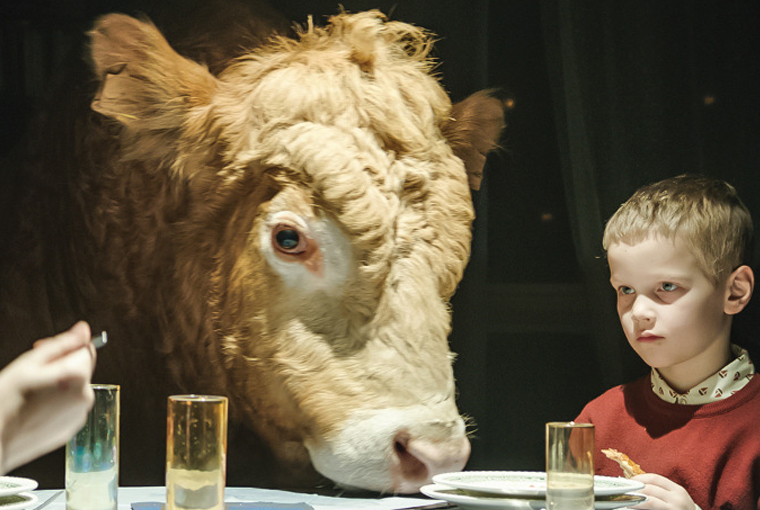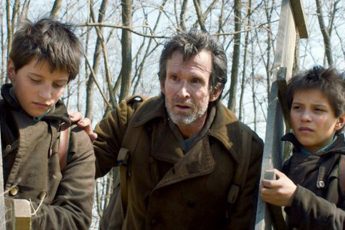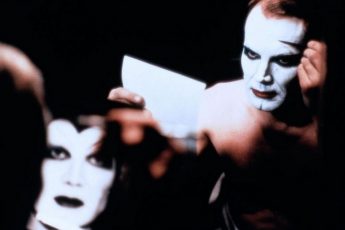Hungarian Phantasmagoria, Vertical Poetries
György Pálfi’s Free Fall (Szabadesés, 2014)
Vol. 74 (April 2017) by Anna Batori
Like Hukkle (2002) and Taxidermia (2006), Pálfi’s Free Fall employs magical realism to create an absurd, isolated, artistic universe full of surreal humor, weird customs, supernatural phenomena and phantasmagorical staging. Joining the current European trend of extreme cinema, Free Fall operates with shock-aesthetics and uses subversive stories and images to provoke the spectator, while simultaneously remaining grounded in the national Hungarian context. The key to Free Fall – and the greatness of the director himself – is this balance of the global and local visual and contextual layers which defines a unique filmic experience that can then be dissected on both a national and transnational level.
Free Fall unfolds seven stories that happen in the neighboring apartments of an old building. What makes the film different from other omnibus productions is that some of those stories often re-connect and/or get continued, while other episodes remain fully isolated, which gives the narrative a rhythmic poetry-structure.
The metre – and the frame – of the story portrays an old, retired couple that get on each other’s nerves. For some reason that remains unknown, the obese, inept wife (Piroska Molnár) decides to jump off the top of the building on her way to the grocery store, and survives the fall. While making her way back to the apartment to do the same act over, she comes across the protagonists of the other stories. This way, Free Fall bears a striking resemblance to Benedek Fliegauf’s Forest (Rengeteg, 2003), though its phantasmagorical quality makes it translate into a more spiritual and fluid experience. Space becomes a key term in the movie, not only in aesthetic terms – the camera has no vertical-horizontal boundaries – but likewise because it functions as a metaphysical message about the interconnectedness of actions and all phenomena in this world, transforming the building into a universal allegory.
The fluidity of space is explicitly articulated in the second episode of the film where the ‘space of energy’ created in a yoga class eventually makes one of the students cross walls. The obese woman performs the same trick but, in contrast to the horizontal movements of the young man, she overcomes spatial boundaries by traveling a vertical trajectory (the staircase of the apartment complex) through which the other stories run. These smaller narratives include a social evening of musicians where one of the female guests appears naked – which, just like in a reverse The Emperor’s New Clothes-story, remains unnoticed by the guests. In another scene, we find ourselves in a television show featuring the everyday routine of a love triangle, while in another episode, we step into the fantasies of a child who projects a cow into the living room.
Beyond doubt, the most disturbing and subversive scenes of Free Fall are connected to sexuality. One of these scenes portrays a couple who live in a hermeneutically sealed, over-sanitized flat to make themselves immune from bacteria and infections. In this fluorescent universe, the couple wears protective clothes and resorts to a second skin made of foil for making love. In this way, they merge with their surroundings and become pure, aluminium-covered objects – a piece of equipment of their white-glazed, postmodern universe. Scared of and obsessed with any kind of dirt and nasty intruder that does not fit the glance, the man eventually murders his partner for imagining her as the source of the cockroach-invasion that he fantasizes about. Drugged and completely on the edge, the young man then destroys the foiled universe with a gun.
Pálfi successfully turns this episode into a political allegory about the incapability of human interactions, and delivers a severe critique of the capitalist-consumerist Western society. In the white-foiled universe, everything is portioned and perfectly structured, be it food, sex or the place of furniture. Emotions, desire and domesticity are thus all part of a bizarre consumer culture that, ironically, annihilates pleasure. By destroying this postmodern sphere, Pálfi points toward the transparency and fragility of the new world, while also emphasizing the psychological effect of the super-structured order on the individual, who eventually becomes demented.
In another transgressive scene, Pálfi portrays a reverse abortion during which a baby is put back in the womb of the mother. Again, the Hungarian director deals with bodies as commodities and, reminiscent of Hukkle and Taxidermia, features them as containers of the surrounding cultural-social processes that affect the individuals. During the reverse abortion, the baby – as an object no longer needed by its creator, the mother – will be absorbed by the womb that delivered it. The product, just as an unwanted product ordered from the internet, is thus sent back to the user.
By treating the body of the child as a no-longer-needed item, the film not only suggests that we are overcoming nature, but that furthermore the human species is being reduced to a simple piece of equipment without a soul. This narrative trope has been characteristic of contemporary European and Hungarian arthouse cinema – see for instance Benedek Fliegauf’s Womb (Méh, 2010), or Szabolcs Hajdu’s Bibliothèque Pascal (2010) that Free Fall strongly overlaps with – suggesting the emergence of a new form of transgressive filmmaking that puts special emphasis on the body as a commodity destroyed by other human objects. To criticize the existing world order and establishment, and draw attention to one’s lack of emotional identification when it comes to numerous surrounding, social-cultural phenomena representative of postmodern societies, filmmakers use the body as the very semantic-pragmatic core of film language.
Correspondingly, to accentuate the film’s corporal base and structure, Free Fall often builds on close-ups and plays with the sound of everyday activities, such as shaving, eating, walking or breathing. The special emphasis on diegetic sound – that strengthens the value of flesh in the segments, and Pálfi’s very concept of the body as organic being – accompanies every scene and, together with Gergely Pohárnok’s precise, fluid camera work, creates a philosophical universe where past and present, traditional and postmodern, old and new all live and exist side by side.
Interestingly, Pálfi places Free Fall into a very Socialist framework, with the in-between episodes shifting from modern (close) to postmodern universes (far future). First, he features a Socialist bloc and an apartment equipped and designed with the furniture, cloths, and food from the previous political epoch. With the old woman jumping down the roof, a certain time-travel starts, moving from capitalism back to Socialism as she later climbs up the stairs. This way, Free Fall follows a similar structure like Taxidermia and Pálfi’s previous films, providing us with a sobering allegory of the old and new world orders.




Leave a Comment